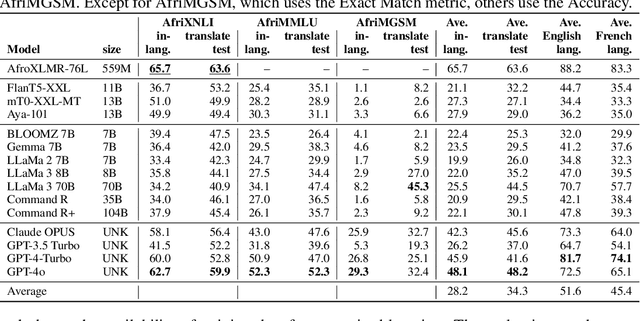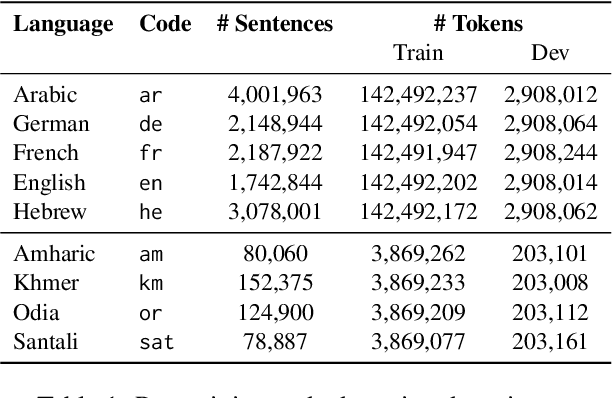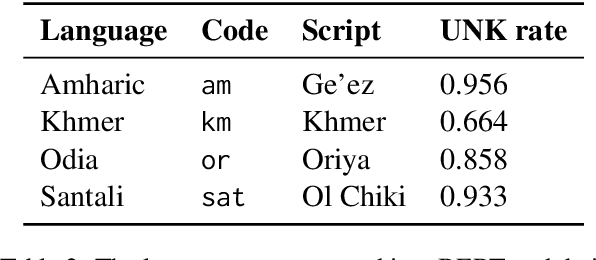Jesujoba O. Alabi
mSTEB: Massively Multilingual Evaluation of LLMs on Speech and Text Tasks
Jun 10, 2025Abstract:Large Language models (LLMs) have demonstrated impressive performance on a wide range of tasks, including in multimodal settings such as speech. However, their evaluation is often limited to English and a few high-resource languages. For low-resource languages, there is no standardized evaluation benchmark. In this paper, we address this gap by introducing mSTEB, a new benchmark to evaluate the performance of LLMs on a wide range of tasks covering language identification, text classification, question answering, and translation tasks on both speech and text modalities. We evaluated the performance of leading LLMs such as Gemini 2.0 Flash and GPT-4o (Audio) and state-of-the-art open models such as Qwen 2 Audio and Gemma 3 27B. Our evaluation shows a wide gap in performance between high-resource and low-resource languages, especially for languages spoken in Africa and Americas/Oceania. Our findings show that more investment is needed to address their under-representation in LLMs coverage.
Charting the Landscape of African NLP: Mapping Progress and Shaping the Road Ahead
May 28, 2025Abstract:With over 2,000 languages and potentially millions of speakers, Africa represents one of the richest linguistic regions in the world. Yet, this diversity is scarcely reflected in state-of-the-art natural language processing (NLP) systems and large language models (LLMs), which predominantly support a narrow set of high-resource languages. This exclusion not only limits the reach and utility of modern NLP technologies but also risks widening the digital divide across linguistic communities. Nevertheless, NLP research on African languages is active and growing. In recent years, there has been a surge of interest in this area, driven by several factors-including the creation of multilingual language resources, the rise of community-led initiatives, and increased support through funding programs. In this survey, we analyze 734 research papers on NLP for African languages published over the past five years, offering a comprehensive overview of recent progress across core tasks. We identify key trends shaping the field and conclude by outlining promising directions to foster more inclusive and sustainable NLP research for African languages.
AFRIDOC-MT: Document-level MT Corpus for African Languages
Jan 10, 2025



Abstract:This paper introduces AFRIDOC-MT, a document-level multi-parallel translation dataset covering English and five African languages: Amharic, Hausa, Swahili, Yor\`ub\'a, and Zulu. The dataset comprises 334 health and 271 information technology news documents, all human-translated from English to these languages. We conduct document-level translation benchmark experiments by evaluating neural machine translation (NMT) models and large language models (LLMs) for translations between English and these languages, at both the sentence and pseudo-document levels. These outputs are realigned to form complete documents for evaluation. Our results indicate that NLLB-200 achieved the best average performance among the standard NMT models, while GPT-4o outperformed general-purpose LLMs. Fine-tuning selected models led to substantial performance gains, but models trained on sentences struggled to generalize effectively to longer documents. Furthermore, our analysis reveals that some LLMs exhibit issues such as under-generation, repetition of words or phrases, and off-target translations, especially for African languages.
YAD: Leveraging T5 for Improved Automatic Diacritization of Yorùbá Text
Dec 28, 2024Abstract:In this work, we present Yor\`ub\'a automatic diacritization (YAD) benchmark dataset for evaluating Yor\`ub\'a diacritization systems. In addition, we pre-train text-to-text transformer, T5 model for Yor\`ub\'a and showed that this model outperform several multilingually trained T5 models. Lastly, we showed that more data and larger models are better at diacritization for Yor\`ub\'a
Uhura: A Benchmark for Evaluating Scientific Question Answering and Truthfulness in Low-Resource African Languages
Dec 01, 2024



Abstract:Evaluations of Large Language Models (LLMs) on knowledge-intensive tasks and factual accuracy often focus on high-resource languages primarily because datasets for low-resource languages (LRLs) are scarce. In this paper, we present Uhura -- a new benchmark that focuses on two tasks in six typologically-diverse African languages, created via human translation of existing English benchmarks. The first dataset, Uhura-ARC-Easy, is composed of multiple-choice science questions. The second, Uhura-TruthfulQA, is a safety benchmark testing the truthfulness of models on topics including health, law, finance, and politics. We highlight the challenges creating benchmarks with highly technical content for LRLs and outline mitigation strategies. Our evaluation reveals a significant performance gap between proprietary models such as GPT-4o and o1-preview, and Claude models, and open-source models like Meta's LLaMA and Google's Gemma. Additionally, all models perform better in English than in African languages. These results indicate that LMs struggle with answering scientific questions and are more prone to generating false claims in low-resource African languages. Our findings underscore the necessity for continuous improvement of multilingual LM capabilities in LRL settings to ensure safe and reliable use in real-world contexts. We open-source the Uhura Benchmark and Uhura Platform to foster further research and development in NLP for LRLs.
AfriHuBERT: A self-supervised speech representation model for African languages
Sep 30, 2024



Abstract:In this work, we present AfriHuBERT, an extension of mHuBERT-147, a state-of-the-art (SOTA) and compact self-supervised learning (SSL) model, originally pretrained on 147 languages. While mHuBERT-147 was pretrained on 16 African languages, we expand this to cover 39 African languages through continued pretraining on 6,500+ hours of speech data aggregated from diverse sources, including 23 newly added languages. We evaluate AfriHuBERT on two key speech tasks: Language Identification (LID) and Automatic Speech Recognition (ASR) using FLEURS dataset. Our results show a +4% F1 score improvement on average for LID and a -1.2% average Word Error Rate (WER) reduction for ASR. Further analysis shows that ASR models trained on AfriHuBERT exhibit improved cross-corpus generalization. Additionally, the analysis indicates that the FLEURS have data quality limitations that may affect their suitability for evaluating low-resource African languages, suggesting the need for better evaluation benchmarks for these languages.
IrokoBench: A New Benchmark for African Languages in the Age of Large Language Models
Jun 05, 2024



Abstract:Despite the widespread adoption of Large language models (LLMs), their remarkable capabilities remain limited to a few high-resource languages. Additionally, many low-resource languages (e.g. African languages) are often evaluated only on basic text classification tasks due to the lack of appropriate or comprehensive benchmarks outside of high-resource languages. In this paper, we introduce IrokoBench -- a human-translated benchmark dataset for 16 typologically-diverse low-resource African languages covering three tasks: natural language inference~(AfriXNLI), mathematical reasoning~(AfriMGSM), and multi-choice knowledge-based QA~(AfriMMLU). We use IrokoBench to evaluate zero-shot, few-shot, and translate-test settings~(where test sets are translated into English) across 10 open and four proprietary LLMs. Our evaluation reveals a significant performance gap between high-resource languages~(such as English and French) and low-resource African languages. We observe a significant performance gap between open and proprietary models, with the highest performing open model, Aya-101 only at 58\% of the best-performing proprietary model GPT-4o performance. Machine translating the test set to English before evaluation helped to close the gap for larger models that are English-centric, like LLaMa 3 70B. These findings suggest that more efforts are needed to develop and adapt LLMs for African languages.
EkoHate: Abusive Language and Hate Speech Detection for Code-switched Political Discussions on Nigerian Twitter
Apr 28, 2024Abstract:Nigerians have a notable online presence and actively discuss political and topical matters. This was particularly evident throughout the 2023 general election, where Twitter was used for campaigning, fact-checking and verification, and even positive and negative discourse. However, little or none has been done in the detection of abusive language and hate speech in Nigeria. In this paper, we curated code-switched Twitter data directed at three musketeers of the governorship election on the most populous and economically vibrant state in Nigeria; Lagos state, with the view to detect offensive speech in political discussions. We developed EkoHate -- an abusive language and hate speech dataset for political discussions between the three candidates and their followers using a binary (normal vs offensive) and fine-grained four-label annotation scheme. We analysed our dataset and provided an empirical evaluation of state-of-the-art methods across both supervised and cross-lingual transfer learning settings. In the supervised setting, our evaluation results in both binary and four-label annotation schemes show that we can achieve 95.1 and 70.3 F1 points respectively. Furthermore, we show that our dataset adequately transfers very well to three publicly available offensive datasets (OLID, HateUS2020, and FountaHate), generalizing to political discussions in other regions like the US.
AAdaM at SemEval-2024 Task 1: Augmentation and Adaptation for Multilingual Semantic Textual Relatedness
Apr 01, 2024



Abstract:This paper presents our system developed for the SemEval-2024 Task 1: Semantic Textual Relatedness for African and Asian Languages. The shared task aims at measuring the semantic textual relatedness between pairs of sentences, with a focus on a range of under-represented languages. In this work, we propose using machine translation for data augmentation to address the low-resource challenge of limited training data. Moreover, we apply task-adaptive pre-training on unlabeled task data to bridge the gap between pre-training and task adaptation. For model training, we investigate both full fine-tuning and adapter-based tuning, and adopt the adapter framework for effective zero-shot cross-lingual transfer. We achieve competitive results in the shared task: our system performs the best among all ranked teams in both subtask A (supervised learning) and subtask C (cross-lingual transfer).
The Hidden Space of Transformer Language Adapters
Feb 20, 2024



Abstract:We analyze the operation of transformer language adapters, which are small modules trained on top of a frozen language model to adapt its predictions to new target languages. We show that adapted predictions mostly evolve in the source language the model was trained on, while the target language becomes pronounced only in the very last layers of the model. Moreover, the adaptation process is gradual and distributed across layers, where it is possible to skip small groups of adapters without decreasing adaptation performance. Last, we show that adapters operate on top of the model's frozen representation space while largely preserving its structure, rather than on an 'isolated' subspace. Our findings provide a deeper view into the adaptation process of language models to new languages, showcasing the constraints imposed on it by the underlying model and introduces practical implications to enhance its efficiency.
 Add to Chrome
Add to Chrome Add to Firefox
Add to Firefox Add to Edge
Add to Edge